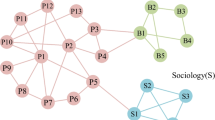Abstract
Conventional community detection approaches in complex network are based on the optimization of a priori decision, i.e., a single quality function designed beforehand. This paper proposes a posteriori decision approach for community detection. The approach includes two phases: in the search phase, a special multi-objective evolutionary algorithm is designed to search for a set of tradeoff partitions that reveal the community structure at different scales in one run; in the decision phase, three model selection criteria and the Possibility Matrix method are proposed to aid decision makers to select the preferable solutions through differentiating the set of optimal solutions according to their qualities. The experiments in five synthetic and real social networks illustrate that, in one run, our method is able to obtain many candidate solutions, which effectively avoids the resolution limit existing in priori decision approaches. In addition, our method can discover more authentic and comprehensive community structures than those priori decision approaches.
Similar content being viewed by others
References
Newman M E J, Girvan M. Finding and evaluating community structure in networks. Physics Review E, 2004, 69(2): 026113
Boccaletti S, Latora V, Moreno Y, Chavez M, Hwang D U. Complex networks: Structure and dynamics. Physics Report, 2006, 424(4/5): 175–308.
Guimera R, Amaral L A N. Functional cartography of complex metabolic networks. Nature, 2005, 433: 895–900.
Palla G, Dereyi I, Farkas I, Vicsek T. Uncovering the overlapping community structure of complex networks in nature and society. Nature, 2005, 435(7043): 814–818.
Danon L, Diaaz-Guilera A, Duch J, Arenas A. Comparing community structure identification. Journal of Statistical Mechanics: Theory and Experiments, 2005, (9): p09008.
Pothen A, Sinmon H, Liou K-P. Partitioning sparse matrices with eigenvectors of graphs. SIAM J.Matrix Anal App., 1990, 11(3): 430–452.
Martin R, Carl T B. An information-theoretic framework for resolving community structure in complex networks. PNAS, 2007, 104(18): 7327–7331.
Fortunato S, Barthelemy M. Resolution limit in community detection. In Proc. the National Academy of Sciences, 2007, 104(1): 36–41.
Reichardt J, Bornholdt S. Statistical mechanics of community detection. Physics Review E, 2006, 74(1): 016110.
Arenas A, Fernandez A, Gomez A. Multiple resolution of modular structure of complex networks. arXiv:physics/0703218v 1, 2007.
Kumpula J M, Saramaki J, Kaski K, Kertesz J. Limit resolution and multiresolution models in complex network community detection. arXiv:0706. 2230v2, Jan. 25, 2008.
Ahn Y Y, Bagrow J P, Lehmann S. Link communities reveal multi-scale complexity in networks. Nature, 2010, 466: 761–764.
Hwang C L, Masud A S M. Multiple Objective Decision Making-Methods and Applications. Berlin: Springer Verlag, Germany, 1979.
Radicchi F, Castellano C, Cecconi F, Loreto V, Parisi D. Defining and identifying communities in networks. PNAS, 2004, 101(9): 2658–2663.
Clauset A, Newman M E J, Moore C. Finding community structure in very large networks. Physical Review E, 2004, 70(6): 06611.
Brandes U, Delling D, Gaetler M et al. On modularity clustering. IEEE Transactions on Knowledge and Data Engineering, 2008, 20(2): 172–188.
Duch J, Arenas A. Community detection in complex networks using extremal optimization. arXiv:condmat/0501368, 2005.
Tasgin M, Bingol H. Community detection in complex networks using genetic algorithm,. arXiv:cond-mat/0604419, 2006.
Shen H, Cheng X, Fang B. Covariance, correlation matrix, and the multiscale community structure of networks. Phys. Rev. E, 82(1): 016114.
Lancichinetti A, Fortunato S, Kertesz J. Detecting the overlapping and hierarchical community structure in complex networks. New Journal of Physics, 2009, 11(3): 033015.
Shen H, Cheng X, Kai C, Hu M. Detect overlapping and hierarchical community structure in networks. Physica A, 2009, 388: 1706–1712.
Shen H, Cheng X, Guo J. Quantifying and identifying the overlapping community structure in networks. Journal of Statistical Mechanics: Theory and Experiment, 2009, P07042.
Shi C, Wang Y, Wu B, Zhong C. A new genetic algorithm for community detection. Complex Sciences, 2009, 5(1): 1298–1309.
Pizzuti C, GA-Net: A genetic algorithm for community detection in social networks. In Proc. PPSN2008, Dortmund, Germany, Sept. 13–17, 2008, pp.1081-1090.
Pizzuti C. Community detection in social networks with genetic algorithms. In Proc. GECCO2008, Alanta, USA, Jul. 12–16, 2008, pp.1137-1138.
Shi C, Zhong C, Yan Z, Cai Y, Wu B. A multi-objective optimization approach for community detection in complex network. In Proc. CEC2010, Barcelona, Spain, Jul. 18–23, 2010, pp.1-8.
Pizzuti C. A multi-objective genetic algorithm for community detection in networks. In Proc. ICTAI 2009, Newark, USA, Nov. 2–4, 2009, pp.379-386.
Handle J, Knowles J. An evolutionary approach to multiobjective clustering. Transaction on Evolutionary Computation, 2007, 11(1): 56–76.
Deb K. Multiobjective Optimization Using Evolutionary Algorithms. Wiley, UK, 2001.
Deb K, Pratab A, Agarwal S, MeyArivan T. A fast and elitist multiobjective genetic algorithm: NSGA-II. IEEE Transaction on Evolutionary Computation, 2002, 6(2): 182–197.
Shi C, Yan Z, Wang Y, Cai Y, Wu B. A genetic algorithm for detecting communities in large scale complex networks. Advances in Complex Systems, 2010, 13(1): 3–17.
Lancichinetti A, Fortunato S, Radicchi F. Benchmark graphs for testing community detection algorithms. Physical Review E, 78(4): 046110.
Du N, Wang B, Wu B. Community detection in complex networks. Journal of Computer Science and Technology, 2008, 23(4): 672–683.
Author information
Authors and Affiliations
Corresponding author
Additional information
Supported by the National Natural Science Foundation of China under Grant Nos. 60905025, 61074128, 61035003, the National High Technology Research and Development 863 Program of China under Grant No. 2009AA04Z136.
Electronic Supplementary Material
Below is the link to the electronic supplementary material.
Rights and permissions
About this article
Cite this article
Shi, C., Yan, ZY., Pan, X. et al. A Posteriori Approach for Community Detection. J. Comput. Sci. Technol. 26, 792–805 (2011). https://doi.org/10.1007/s11390-011-0178-z
Received:
Revised:
Published:
Issue Date:
DOI: https://doi.org/10.1007/s11390-011-0178-z




